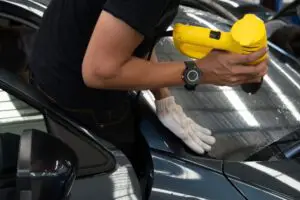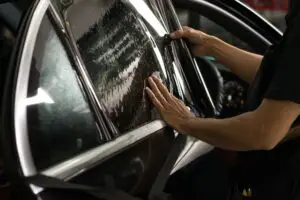Were you thinking about having your windows tinted?
However, you are worried about getting a ticket?
You’ve landed at the right article. Window tinting is practically required in Georgia.
Tinting your windows help to conserve you and your vehicle from the sun’s harmful rays, but it also helps maintain your privacy.
Understanding your regional rules is vital whether you want to tint your windows for UV safety or an extra relaxing journey.
Georgia window tint laws indicate that you should use non-reflective tint on the windshield with any shade permitted on the top six inches.
The front side windows should have darkness of around 32% visible light transmission, and the backside and rear windows can use any darkness.
Now that you know how much darkness is allowed, it will be best for you to read the article until the end to have a clear understanding.
I have also included frequently asked questions to make you understand better, so be sure to check them.
Table of Contents
- 1 How Much Tint Darkness Is Legal In Georgia?
- 2 Window Tint Reflection And Tint Colors
- 3 Medical Exemption Of Window Tint Laws In Georgia
- 4 Get A Certified Sticker From The Company
- 5 Other Window Tint Law Rules And Regulations In Georgia
- 6 Cost Of Car Window Tint In Georgia
- 7 Frequently Asked Questions
- 8 Conclusion
How Much Tint Darkness Is Legal In Georgia?

To determine how much tint of darkness is allowed in Georgia, you must measure the Visible Light Transmission (VLT).
This is the quantity of noticeable light permitted inside through the window and the film that has been placed.
Georgia’s automobile tint legislation was passed in 2005 and specifically outlines the ultimate percentage of window tint that can be used.
They’re made to give drivers the advantages of vehicle tinting at the same time while still allowing them to see sufficiently to drive safely.
Tint Darkness Limit For SUVs And Vans
Starting with the tint darkness limit on SUVs and vans, you must know that the windshield should be utilized with a non-reflective tint but keep in mind that any shade of tint can be used on the over six inches of the windshield.
Besides that, the front seat side mirrors should have around 32% visible light transmission darkness, but it can also be more than that.
Lastly, the back seat side mirrors, as well as the rear windows, can use any darkness level as well as visible light transmission percentage.
Tint Darkness Limit For Sedans
Now coming over to the tint darkness limit for sedans, you need to know that this is different from the SUVs and vans, so make sure to follow the rules accordingly.
1. Front Windshield
On the windshield, make sure to use non-reflective tint, but you should know that you can use any tint shade on the very top six inches of your vehicle’s windshield.
2. Front Seat Side Windows
The front-seat side windows must have around 32% visible light transmission darkness, but keep in mind that it can also be more than that.
3. Rear Window
The rear windows must also have about 32% visible light transmission darkness.
4. Back Seat Side Windows
Lastly, the back seat side windows have the same VLT percentage as the rear window and the front seat side windows, which are around 32% or more.
Window Tint Reflection And Tint Colors
- Sedans and coupes and SUVs and vans’ front-seat side mirrors should not be above 20 percent reflective.
- The back seat, side mirrors for the sedans and coupes, and SUVs and vans should be more than 20 percent reflective.
- When it comes to the window tint colors, you must know that you can use any color except red and amber.
Medical Exemption Of Window Tint Laws In Georgia

Several people with medical issues qualify for a medical exemption under the Georgia window tint law.
You need to complete an application for a window tint authorization to apply.
A state-licensed doctor and an optometrist can verify the requirement for extra sun protection.
Visible light transmission is allowed in 23 percent of cases due to medical exemptions.
You may be able to safely have a customized window tint added to the automobile once it has been accepted.
This, like standard automobile window tint, authorizes for a 3 percent variation.
Even if you have an exception, you can’t have a tint that lets in shorter than 23 percent of the light.
In Georgia, the application will be denied for an exemption if guarding eyewear is adequate to cope with the medical problem you may have.
Get A Certified Sticker From The Company
Any items and objects that impede or limit the driver’s unobstructed vision of the road are said to be prohibited in the state of Georgia.
Only window tint stickers, enrollment or examination stickers, and other stickers mandated by State law or a local community are permitted under Georgia’s window sticker constitutions.
You must also remember that all additional stickers that are not needed by law could be prohibited on the front windshields and the back side windows.
Other Window Tint Law Rules And Regulations In Georgia
Here I will be listing down additional window tint law rules and regulations required in the state of Georgia, so make sure to read and imply them.
- State certification is required of film producers. Check if the film you’re buying or having installed is authorized.
- You will need to get a medical exemption in Georgia for particular tints.
- There are said to be no restrictions mentioned for side mirrors of a vehicle in Georgia.
- You need to make sure that the stickers that say the tinting done on your vehicle is legal must be placed on the vehicle’s windshield.
- Do not use the colors red and amber for tinting because they are illegal in Georgia.
- The state of Georgia allows for a 3-percentage-point tolerance in visible light transmission.
These are the additional laws that you must follow in Georgia so you can drive safely and without any problems, or else you will be stopped by cops and end up paying a huge sum of fines.
Cost Of Car Window Tint In Georgia
Window tinting prices in the state of Georgia may vary depending on the brand and the type of tint that is being used.
However, you must keep in mind that normal, mainly non-reflective film costs around $250 up to $600 for a passenger automobile.
It is also worth mentioning that it can cost up to $800 for high-performance ceramic and metallic film.
You will need to make a wise choice before buying, which will make the vehicle look more appealing.
However, make sure to follow all the rules and regulations before buying and choose the right tint level that will provide sun protection and make it easier for you to see through.
Frequently Asked Questions
Q1. Is 15% Tint Legal In Georgia?
No, 15% tint is not legal in Georgia because it can be slightly dark. You can only use non-reflective tint, mainly in the top six inches of the windshield.
Besides, above 32 percent of light must pass through the front side windows. Besides that, backside windows can use any darkness or more than 32%.
Q2. Are 5% Tints Legal In Georgia?
No, 5% tints are not legal in Georgia. The windshield cannot be tinted from the front side, and only the top six inches can use non-reflective tint.
The rear and backside windows can be on any dark level of more than 32 percent.
Q3. Is Limo Tint Legal In Georgia?
Limo tint is said to be too dark, which can affect visibility. This is why it is not legal in the State of Georgia.
Q4. Can I Get Pulled Over For Tint In Georgia?
Yes, you can get pulled over for tint in Georgia. You must know that if it is your first time, you’ll probably be charged around a $25 fine and a fix-it ticket.
Q5. How Much Is A Tint Ticket In Georgia?
Well, if you are someone who has a vehicle with an inaccurate window tint or something that is below 32 percent, then be prepared to get a ticket of $124 or even more, depending on how serious the concern is.
Conclusion
Georgia tint laws show how important it is to drive responsibly while following the rules, or else you will end up with serious consequences.
The rules are simple and easy to follow, so make sure to apply them to the vehicle you own accordingly.
I have mentioned the laws in Georgia for Sedans, SUVs, and vans, so you need to make a wise decision.
I have also included rules and regulations and answered some of the most important questions that many people tend to ask so you can have a more knowledgeable awareness of laws in Georgia.

I am Tahir Azam, and I have been writing amazing articles for TaxiHack for as long as I can remember. I know everything that is to know when it comes to automobiles and is always on top of industry news and developments. While I am not an expert by any means, I pride myself on knowing the ins and outs of many different problems and, of course, their solutions. The articles on our website are some of the best and well-researched content that you will find, and I spend countless hours making sure this remains to be true. This is why I ask you to take your time out and read some of my articles, especially if you find a topic that resonates with you or is something you are looking into. This way, you will find the perfect mix of information and tips on your desired topic. Learn more about Tahir.



